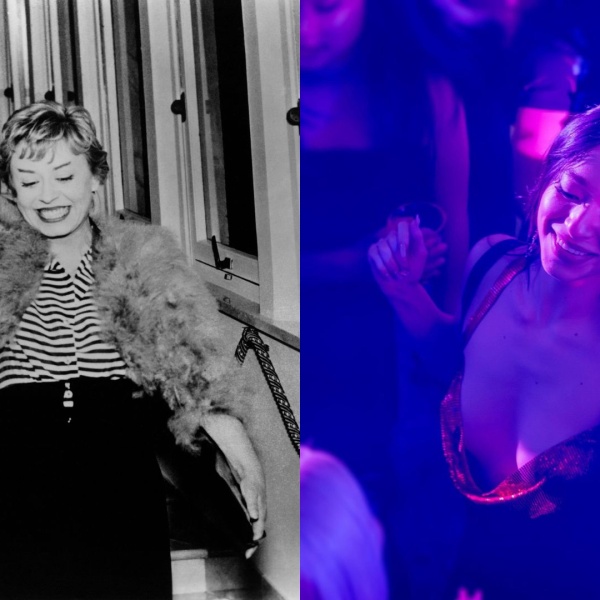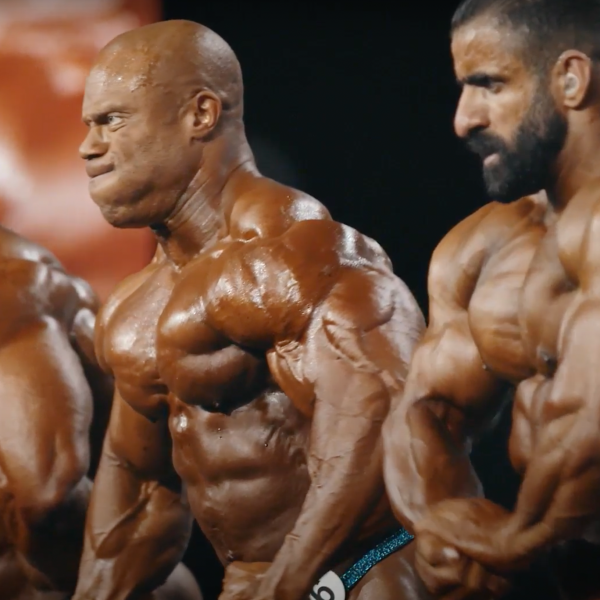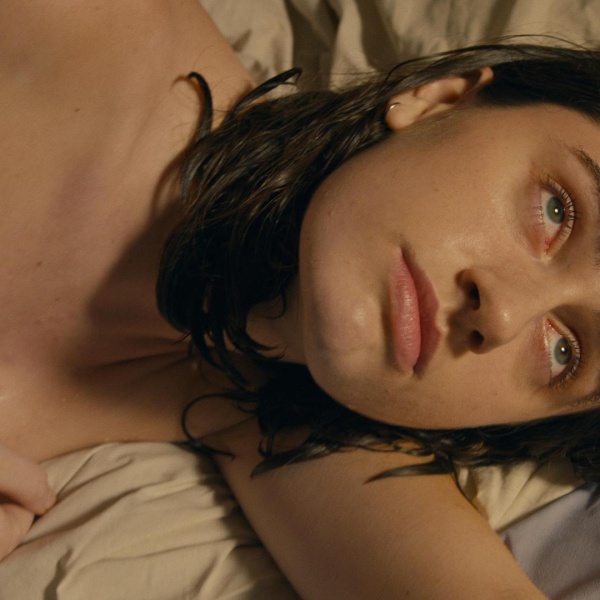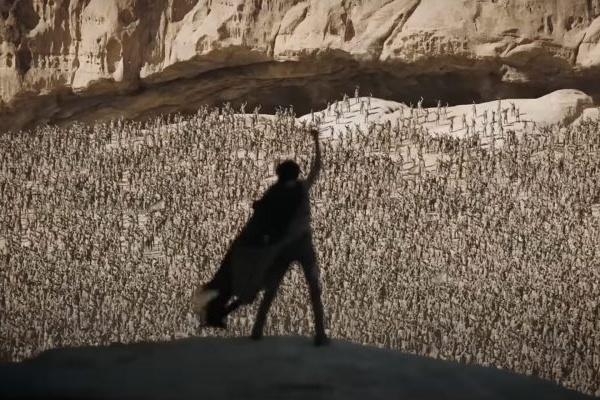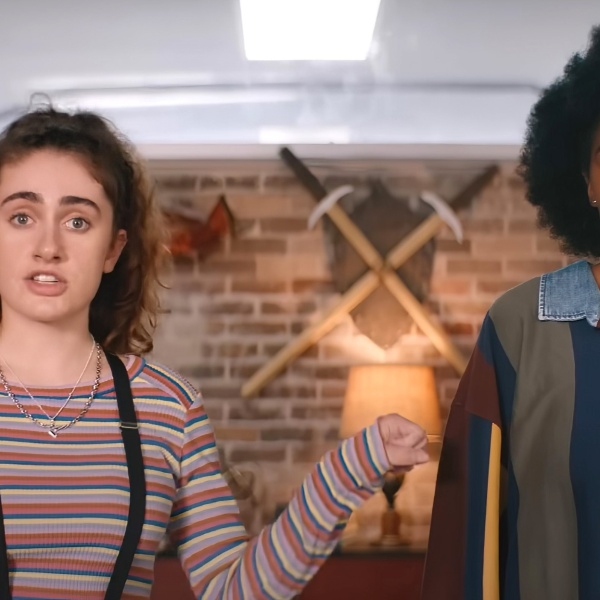 Art rises to a challenge, and 2023 saw plenty of documentaries do exactly that. Amid a swarm of vanity projects and puff pieces, brand extensions and overstretched stories, the best documentaries of the year stood out for their scrutiny and decisiveness; their unique perspectives and razor-sharp editing. Rather than be dragged down by industry forces, be it the lingering effects of streaming or resurgent demand for star vehicles masked as docs, these 20 nonfiction works rose above — and, as audience members, we thank them for it.
Art rises to a challenge, and 2023 saw plenty of documentaries do exactly that. Amid a swarm of vanity projects and puff pieces, brand extensions and overstretched stories, the best documentaries of the year stood out for their scrutiny and decisiveness; their unique perspectives and razor-sharp editing. Rather than be dragged down by industry forces, be it the lingering effects of streaming or resurgent demand for star vehicles masked as docs, these 20 nonfiction works rose above — and, as audience members, we thank them for it.
There were some heavy hitters working in 2023. Matthew Heineman, Maite Alberdi, Steve James, and Errol Morris all delivered impressive new pieces. Breakthroughs came screaming to the forefront as well, many aided by festival or critical support (or both). Films like “Kokomo City,” “Beyond Utopia,” and “A Still Small Voice” managed to crack the zeitgeist and pique cinephiles’ interest. While over in television, genre hybrids like “Paul T. Goldman” and experimental adaptations (like “The 1619 Project”) got people talking, and plenty of powerful stories found room to grow and expand along with their audience. (“How To with John Wilson,” you will be missed.)
The documentary landscape is shifting, along with an industry adapting to a new reality. To some, the end of the “too much TV” era and the studios’ slow pivot away from streaming indicates less space for documentaries, even if there’s more demand for true crime tales and continuations of established hits. (Get ready for “The Jinx 2” in 2024 — no, really.) But to others, it’s just another sea change. Hollywood has seen them before, and we’ll see them again. Documentaries always find a way through, and this adjustment will be no different. Instead of feeling worried or threatened, take heart in the abundant offerings that broke through in 2023. Below, we’ve listed the best documentaries of the year — listedin alphabetical order — for both features and series. Enjoy, and don’t worry: There will be even more next year.
Kate Erbland, Marcus Jones, Ryan Lattanzio, Tony Maglio, Mark Peikert, Sarah Shachat, and Brian Welk contributed to this list.
-
1. “American Symphony”

Image Credit: Netflix What starts as a fascinating portrait of Oscar- and Grammy-winning New Orleans musician Jon Batiste attempting to expand the definition of a symphony with his pending Carnegie Hall debut contracts into something much more intimate. Director Matthew Heineman, more often known for taking audiences to the frontlines of war, is uniquely adept at capturing the former “Late Show” bandleader and Suleika Jaouad, his successful author and wife, battle some of the greatest challenges that life can throw. Meanwhile, Batiste’s emotional rollercoaster of a personal life runs parallel to the pinnacle of his career, as he becomes the first Black artist to win Album of the Year in over a decade. Quite simply, “American Symphony” needs to be seen to be believed. —MJ
-
2. “Beyond Utopia”

Image Credit: Courtesy of Getty Images This nonfiction exposé reveals what it’s like to live in North Korea — and to try to escape. Editor-turned-director Madeleine Gavin (“City of Joy”) tracks two riveting and dangerous attempts at defection in this eye-openier which won the U.S. documentary audience award at Sundance 2023. After some reluctance to tackle the subject of North Korea, Gavin’s deep research persuaded her to dive in, including hidden camera footage that had been brought out (some of which is in the film). Gavin tracks two narratives, as heroic underground railroad leader Pastor Kim steers the Roh family of five (including two children and an 80-year-old grandmother), with the help of 50 brokers, on a torturous journey over jungles, mountains, and rivers, through Communist countries China, Vietnam, and Laos before they reach safety in Thailand. He also tries to help a mother, Soyeon Lee, who — having successfully defected to South Korea — struggles to bring her 17-year-old son to join her.
As much as the Roh story is riveting, dangerous, and rigorous — often shot with iPhones by the participants themselves — the heartbreaking narrative is Soyeon Lee’s unsuccessful attempts to rescue her son, which we watch unfold in real time. Gavin expertly threads the two storylines, while also providing snippets of history and what it’s like to live in North Korea. “Beyond Utopia” is landing key documentary nominations on the road to the Oscars. The film nabbed four Critics Choice nods, including Best Feature, and will vie for the Cinema Eye Honors audience award. —AT
-
3. “Bill Russell: Legend”

Image Credit: Courtesy of AP Images / Netflix The savvy and power of “Bill Russell: Legend” can be gleaned from one seemingly innocuous detail: The two-part documentary features plenty of talking heads, from NBA greats Magic Johnson and Stephen Curry to Russell’s family members and the titular legend himself. It’s also narrated, quite well, by Corey Stoll. But there’s another voice that’s instrumental to director Sam Pollard’s story: Jeffrey Wright’s. The “American Fiction” star reads passages from Russell’s memoirs, pulling key quotes directly from the legendary center’s writing, by way of providing insight into times long past and memories that risk being forgotten.
“Bill Russell: Legend” is dedicated not just to its subject, but to each of his many sides: a basketball great worthy of study for his sheer skill alone; a winner with more team titles and personal triumphs than many dare to dream possible; a civil rights icon whose unflinching fight for racial equality began long before he became a beloved American athlete and continued long after he could sprint from one end of the Boston Garden to the other. Pollard’s film leaves no stone unturned, without bloating itself beyond its most potent version. Including Russell’s memoirs — his memories, his own recollection of events — by way of Wright’s distinct yet expressive recitation not only shows the film’s commitment to reflecting Russell’s fascinating life, but also to ingraining it in as many memories as possible. It’s a story worth telling, and a story that demands to be told well. —BT
-
4. “Break Point”

Image Credit: Courtesy of Netflix Netflix released the first part of “Break Point” Season 1 on January 13, 2023; the back half would wait until June 21. The “break” in “Break Point” kept tennis fans in suspense, but it was really a production necessity. Like “Formula 1: Drive to Survive” (the two share the same production company), 2023 IndieWire honorable mention “Quarterback,” and other similar Netflix sports docuseries, you don’t have to be a fan of the sport to be a fan of the show. These well-done documentaries are about the personalities and the stakes, not just the matches, races, and games. “Break Point” makes viewers love Ons Jabeur — and love to hate Nick Kyrgios (if you didn’t already).
The first set in “Break Point” covers the Australian Open, Indian Wells, and the French Open. It’s enough to capture viewers and a Season 2-renewal from Netflix. Wimbledon, the U.S. Open, and the WTA and ATP Finals have to wait for summer. —TM
-
5. “The Deepest Breath”

Image Credit: Netflix Laura McGann’s “The Deepest Breath” will, forgive us, have you holding yours, as the filmmaker spins through a heart-stopping true story (and a tragic one at that), framed through gut-churning footage that approximates the feeling of being a freediver (like the subjects of the film) as they plunge ever-deeper in pursuit of a crazy dream.
While the story at the heart of the Netflix feature — which follows the paths of freedivers Alessia Zecchini and Stephen Keenan as they pursue their passions (and, for awhile, each other) — is compelling enough (and that’s even without knowing both of the film’s subjects don’t make it out of this story alive), it’s how the entire outing is presented that thrills. Zecchini, Keenan, and myriad other talking heads are driven to dive to insane depths on a single breath (of note: viewers will learn significantly more about the rules of the sport), a pursuit that sounds nuts and is even more shocking in practice. McGann and her team strive to show us as much of that practice as possible, all organized around a story that somehow also feels remarkably relatable.
Think of it this way: I watched this film on a plane, and even I couldn’t catch my breath the entire time. To call it “immersive” is only breaks the surface. —KE
-
6. “The Eternal Memory”

Image Credit: Courtesy of MTV Documentary Films A vivid docu-essay, a moving romance, and a resonant metaphor for Chilean dictatorship, Maite Alberdi’s “The Eternal Memory” documents the impact of Alzheimer’s on married couple Augusto Góngora and Paula Urruti. Working for some 60 hours of footage, Alberdi follows Góngora’s rapid mental decline and actress-turned-Minister of Culture and the Arts Urruti’s loving efforts to make his final years as joy-filled as possible, even as the COVID pandemic accelerates his condition. Góngora died in June this year, just six months after the film first premiered at Sundance, but he left behind a long legacy of keeping the atrocities of Pinochet’s rule preserved in the national memory.
“The Mole Agent” director Alberdi not only assembles archival footage and home videos spanning their 23-year relationship, but also captures intimate new footage of the couple alone at home or revisiting their past over meals or physical therapy sessions while Góngora slips away but tries to stay tethered to reality. Meanwhile, Góngora’s personal connections to Chilean national trauma, including the murder of a colleague, give the film a political urgency that — using dreamlike editing that hops, skips, and free-associates in ways memory does — threads seamlessly within a portrait of a marriage battling time. Memory is a collective experience, whether in human or political terms, and “The Eternal Memory” is a touching reminder of what shouldn’t be forgotten even amid unknowable disease. —RL
-
7. “Every Body”

Image Credit: Courtesy of Focus Features Explaining what the “I” is in LGBTQIA+ should not be this lighthearted of a viewing experience. Make no mistake: The coming-out stories and hardship of intersex people as told in “Every Body” are emotional and difficult conversations. But director Julie Cohen (“RBG”) develops such trust with the film’s three subjects that they’re often willing to frankly discuss their genitalia, chromosomes, and other thorny identity questions in ways that are inspiring, funny, and easy to comprehend, whether you’re straight or part of that wider queer spectrum.
Cohen gets laughs out of activist and writer Alicia Roth Weigel dismantling a conservative pundit who insists there are only two genders. She repurposes a previously salacious “Dateline” story into the context of how doctors trying to impose gender norms has had ripple effects on intersex individuals for generations. She even weaves gender-flipped versions of pop staples into the soundtrack to further drive home the point of gender not being a binary. It’s essential viewing that never feels like homework. —BW
-
8. “How To with John Wilson” Season 3

Image Credit: Courtesy of Thomas Wilson / HBO John Wilson calls each episode of “How To with John Wilson” a movie, not a documentary. But the structure of his now-concluded HBO series shows just how emotional and personal a great storyteller can get by using building blocks of the documentary form. Each episode is constructed out of Wilson’s astonishing eye for found footage, of course. He interviews subjects and organizes each entry with voiceover narration. There is an explicit hunt for information about a topic, like how to get into bird-watching, or how package delivery works in a city as big as New York. But of course the true subject of “How To with John Wilson” is Wilson’s own interest-spirals, as each episode transforms a straightforward question into an odyssey through how bizarre and unexpected humans can be, which then ends up reinforcing Wilson’s initial curiosity.
The result is that “How To with John Wilson” doesn’t just feel factually accurate, but emotionally true. It’s a show that’s constructed and real, and somehow lives in the poetry Wilson is able to make out of real New Yorkers just waiting on the subway. “How To with John Wilson” stands as a series of sometimes absurd, sometimes profound, really funny movies. We’re so glad we watched them. —SS
-
9. “Judy Blume Forever”

Image Credit: Amazon Throughout Davina Pardo and Leah Wolchok’s warm-hearted documentary “Judy Blume Forever,” the beloved American author is joined by a number of talking heads — a classy assortment, from Blume’s own kids and childhood pals to fellow authors like Mary H.K. Choi and Jacqueline Woodson, plus famous devotees like Lena Dunham and Molly Ringwald, as well as long-time fans (and Blume pen pals) Lorrie Kim and Karen Chilstrom. It should come as little surprise that the best-selling author gets (even to this day!) tons of fan mail, but that Blume delights in saving much of it, often responding to it, and truly cherishing it is just one of the pleasures to be found in this nourishing doc.
Organized mostly chronologically, Blume herself walks us through some of her biggest books and what was going on in her life at the time she was writing them (cute and kicky animations provide a backdrop when Blume reads aloud from her works). Firstly, though, there is her childhood, which sheds light on how some of Blume’s most essential obsessions formed. A child of World War II (she keenly remembers turning seven as it ended), Blume still recalls the feeling that adults weren’t being totally truthful with her about the big stuff. The war was “far away” and couldn’t hurt her. She didn’t need to worry about her father’s health. Being happy was easy. Even as a kiddo, Blume knew it was bunk.
But who could tell other kids that? Eventually, Judy Blume could, though “Judy Blume Forever” also takes us through the many years before she reached that point: swapping secrets with gal pals in high school, going to college to find a husband, always hoping to meet an ideal that didn’t actually appeal to her. Blume was a late bloomer, at least when it comes to her work, and she’s remarkably frank about the years spent not writing (and wanting to) and then early attempts (that were not appreciated). But Blume’s belief that what she was doing was important and was going to help kids feel less alone drove her, and — guess what? — proved to be totally true. —KE
-
10. “Kokomo City”

Image Credit: Magnolia Pictures/D. Smith D. Smith’s Sundance sensation “Kokomo City” is a rollicking first feature that focuses on the lives of four Black trans sex workers who live in Georgia and New York, illuminating the joy and hardships they face, and imbued with plenty of wit as we get to know this fascinating quartet and their hard-won points of views while living ever in flux. “Kokomo City” in 2023 feels as urgent and revolutionary as something like Jennie Livingston’s ball-culture panoramic “Paris Is Burning” did in 1990.
A lively black-and-white portrait of trans women delivering hope, wisdom, and cutting truth, “Kokomo City” was unfortunately mired in a real-life tragedy that brings an unfortunately timely resonance to the film, given the current forces working politically against LGBTQ people in America. One of the film’s subjects, Koko Da Doll, was murdered this past April not long after the film’s Sundance premiere. Songwriter-turned-filmmaker D. Smith is the ideal and compelling cinematic voice to tell this story — in the documentary’s contrast of black-and-white lighting, its needle drops and deep-cut tracks, and an indie spirit that suffuses every frame. Smith waxes as poetic as her subjects. —RL
-
11. “Last Call: When a Serial Killer Stalked Queer New York”

Image Credit: Courtesy of HBO Serial killer true crime stories are a genre in and of themselves — so much so that the repeated revisiting of murderers like Jeffrey Dahmer and John Wayne Gacy almost turn them into clichés that threaten to trivialize the very real consequences of their killings. But rarely are true crime and social justice as cohesively intertwined on the small screen as they are in “Last Call: When a Serial Killer Stalked Queer New York,” a four-part docuseries from HBO.
Directed by Anthony Caronna and executive produced by Howard Gertler from Elon Green’s 2021 nonfiction book, “Last Call” pulls back the curtain on the killing spree of Richard Rogers, a male nurse who, as far back as the 1980s and until 2001 (when he was eventually caught by authorities), targeted gay men in New York and New Jersey. (Prior, in 1973, he was acquitted of killing his college housemate in what he alleged was a fit of gay panic.) His reign of terror also fell at a time when queer people were under siege by the NYPD and whose stories were largely ignored by the mainstream media amid the AIDS crisis and the still-felt influence of the Anita Bryants of the world. Through sensitively conducted interviews with the victims’ surviving family members, friends, and lovers, and through noirish reenactments that recall the work of Errol Morris and “The Thin Blue Line,” “Last Call” seeks to reclaim those stories and the socially vulnerable people who tell them. —RL
-
12. “Love Has Won: The Cult of Mother God”

Image Credit: Courtesy of HBO The world is so much more fucked up than we can ever know. That’s what I kept thinking watching Hannah Olson’s HBO docuseries “Love Has Won: The Cult of Mother God,” the sort of portrait of a sick-at-the-roots fanatical American underbelly that makes you feel like you have the flu watching it, its bad vibes imbuing your own. Executive-produced by the Safdies among others, “Love Has Won” centers on the rise of Love Has Won cult leader Amy Carlson, aka Mother God, whose body was found mummified in April 2021 in her Crestone, Colorado compound, ensconced in a sleeping bag and Christmas lights, her skin a dark steely blue after years of chronically ingesting colloidal silver.
After opening with that harrowing image of Carlson’s desiccated corpse as Saguache County authorities raid Love Has Won’s stomping grounds, the docuseries retraces how Carlson convinced a few dozen impressionable conspiracy theorists and lost souls to follow her out West. The group’s specific dogma — built around the concept that its acolytes are “lightworkers” who can communicate with aliens — is almost impossible to parse, often emerging out of Carlson’s drunken and drug-addled ravings and stupors. She also believes she’s the reincarnation of some 500 luminaries, from Harriet Tubman to Robin Williams. (When she goes into an especially drunken rampage, one follower says that’s in fact Robin in the room.)
While cult documentaries are a dime a dozen dating back to Netflix’s smash “Wild Wild Country,” Olson’s “Love Has Won” is exceptionally well-crafted from the talking-heads interviews with subjects still mentally in the cult and those who escaped. There’s no moral astringence or reckoning with trauma, as the cult is still so new and still has its hooks firmly in a few who remain unable to reframe their brainwashed delusion as just that. Already the word-of-mouth nonfiction hit of the winter TV season, “Love Has Won” is worth a rewatch for the cult’s dense and unfurling mythology, but there are so many “WTF did I just watch?!” moments that it succeeds as a true, tawdry piece of entertainment on its own terms. —RL
-
13. “The Luckiest Guy in the World”

Image Credit: Courtesy of ESPN Films Steve James doesn’t miss. Not when he’s directing one of the most influential documentaries of all time, not when he’s pivoting to streaming via top-tier docuseries, and not when he’s making one entry in ESPN’s long-running “30 for 30” franchise — a chapter about the famed basketball star and commentator, Bill Walton. While providing a thorough portrait of the Oregon athlete’s life and profession, James also challenges Walton, whose easygoing nature helped make him one of the cheeriest sports stars of his era. The director does this in both storytelling structure and interview style. He dives headfirst into Walton’s successful career on the court, showing highlight reels that emphasize his dominance, while still finding time to speak to his shifting public image.
Walton’s college-era protests of the Vietnam War cast him as an agitator, even in hippie-friendly California, while injuries in the NBA cost him years of his prime. Seeing Walton prickle at accusations that he was cashing a paycheck while feigning pain only speaks to his character, his commitment, and his love of the game. They draw you closer to him, even though they clearly created a gap between filmmaker and subject. Walton wants you to be happy for him; he’s the self- (and oft-)described “luckiest guy in the world.” But James’ job is to showcase not just why he believes that, but what challenges Walton overcame to maintain such a positive perspective, as well as what he may be overlooking to make those views easier to hold onto. With so many over-polished vanity docs out there, James reminds us what a great documentarian can do with an objective lens. No matter the assignment, James just doesn’t miss. —BT
-
14. “The Mother of All Lies”

Image Credit: Cannes At the beginning of Asmae ElMoudir’s innovative hybrid documentary, which uses clay puppets fashioned by the filmmaker’s father to recreate incidents from her family’s past, we meet her formidable grandmother Zahra. She has long refused to allow any photographs in her home, preferring to keep the past under lock and key. Only after three years, when ElMoudir threatened to hire an actress to play her, did Zahra agree to play herself.
The film took eight years to finish; the filmmaker was determined to blow things up by bringing people in to interact with the dolls in their atelier three hours from Casablanca, to provide space away from their homes. The strategy is effective, as grown men are reduced to tears. One man recalls being thrown in a prison cell full of dead bodies during the 1981 Casablanca bread riots, among other horrors.
Although the co-production between Morocco, Egypt, Qatar and Saudi Arabia shared the documentary prize at Cannes, won the Un Certain Regard Best Director award, was selected as the Moroccan Oscar entry, and nominated for Best Documentary at the Indie Spirits, the film still lacks distribution. —AT
-
15. “Paul T. Goldman”

Image Credit: Courtesy of Evans Vestal Ward / Peacock We’re going in the way-back machine for this blurb — or at least as far as you can go back in 2023. “Paul T. Goldman” debuted January 1 on Peacock, but we were already hooked by its trailer in late 2022.
Where do we even start in attempting to explain “Paul T. Goldman” to someone who hasn’t seen it? OK, so… it goes like this: Jason Woliner’s “true”-crime docuseries is an adaptation of Paul Finkelman’s semi-autobiographical self-published book. Who adapted the book, you might ask? Finkelman did, turning it into a screenplay and later the TV series. If only Finkelman could find the perfect leading man— oh right, he did all the acting too.
Goldman/Finkelman’s life story, including the discovery that his wife was running an international sex-trafficking ring, is almost too crazy to believe. That’s probably a good catch though, because it’s not true — not beyond being the story Paul tells himself (and others) to escape his mundane reality. Believe it or not, this zig-zagging summary only scratches the surface of one of the year’s most ambitious series. If you like cringe-watch TV, cringe-stream this one. —TM
-
16. “The 1619 Project”

Image Credit: Courtesy of Hulu An adaptation of the Pulitzer Prize-winning project from The New York Times magazine sees its public face, journalist Nikole Hannah-Jones, lead a discussion of six different facets of Black life in America. Trying to have a nuanced, exhaustive conversation about the African American community’s relationship with capitalism or democracy is incredibly daunting, but Hannah-Jones makes it all work by leading with vulnerability. Her own life experience as a biracial woman from Iowa works well in disarming her interview subjects, often leading to conversations that end with healing tears. The “Music” episode is a particular highlight as a lot of people have interviewed legendary music producer Nile Rodgers over the years, but none have tapped so well into his singular genius. Coming from producers Roger Ross Williams and Shoshana Guy, who also worked on Netflix’s “High on the Hog,” the Emmy-nominated Hulu series is also shot just as beautifully. —MJ
-
17. “Still: A Michael J. Fox Movie”

Image Credit: AppleTV+ Oscar-winner Davis Guggenheim (“An Inconvenient Truth”), whose Concordia studio has a first look deal at Apple TV+, pitched the studio a documentary based on Michael J. Fox’s four books that “feels like an ’80s movie.” And that is what he delivered, thanks to clever use of archive footage from Fox’s career, spanning his hit TV show “Family Ties” to the “Back to the Future” series. Editor Michael Harte artfully splices Fox’s iconic roles with seven Interrotron interviews with the star, who is struggling with Parkinson’s. The movie has scale: elaborate reenactments, plenty of hit singles, a lush Hollywood score, and a charming narrator, Fox, reading his book on tape. The movie takes the audience on a helluva ride.
What sucked Guggenheim in was the quality of Fox’s writing. The opening of the movie comes straight from the book: After a night of partying with Woody Harrelson, Fox wakes up in a haze and sees his pinky trembling. The movie shows the diminutive actor on the move from the start, convincing his conservative father at age 18 to take him to L.A. for auditions. When he landed some roles, his father left him behind to manage on his own. “Family Ties” arrived just in time. Gary David Goldberg hired Fox over the objections of NBC president Brandon Tartikoff, who said he couldn’t imagine seeing Fox’s face on a lunchbox. Years later, after the top-rated show had won five Primetime Emmys including three for Fox, the actor sent Tartikoff a signed “Family Ties” lunchbox, which the network czar kept in his office for years. —AT
-
18. “Stolen Youth: Inside the Cult at Sarah Lawrence”

Image Credit: Courtesy of Hulu As a Sarah Lawrence alum, when New York Magazine broke the news about a cult that formed in 2010 in one of the dorms, I thought it was the most Sarah Lawrence thing I’d ever heard. But that magazine article was in no way preparation for “Stolen Youth,” a docuseries that harnesses its outrage to build upon the horrors perpetuated by Larry Ray. Watching survivors and witnesses share their stories (often brutal, always heartbreaking) and seeing an entire family destroyed by his manipulation and machinations is not the usual voyeuristic chill that comes from a cult documentary. There was real cruelty on display (literally, thanks to the trial that made the videos Ray recorded available to include here), and the victims’ terror and disappointment in themselves is palpable. “Stolen Youth” made the bold choice to never interview Ray; his defense is meaningless in the face of such destruction. “Stolen Youth” is never an easy watch, but it always feels like a necessary one. —MP
-
19. “Telemarketers”

Image Credit: Telemarketers HBO documentary series Telemarketers are not exactly well-liked. Even before the nagging hucksters interrupting your evening dinner were replaced with robo-calls, public sentiment toward the entry-level profession wasn’t exactly sympathetic. So consider what directors Adam Bhala Lough and Sam Lipman-Stern do in HBO’s three-part documentary series, “Telemarketers,” a minor miracle. Not only does it convincingly make the case that these callers were a product of their environment — both broadly (aka predatory capitalism) and specifically (largely unmonitored offices that could get wildly out of hand) — but it creates an endearing personal portrait that’s half buddy comedy, half investigative drama.
Lipman-Stern co-stars as a former telemarketer who sets out to expose an industry-wide, insanely lucrative scam with the help of his former co-worker — and favorite on-camera star — Patrick J. Pespas. Lipman-Stern started bringing his camcorder to work decades prior, often capturing the drunk and disorderly chaos that kept phone bank employees coming back to make more calls. Just as often, he would speak directly to the camera, asking questions that would persist beyond his telemarketing career. Eventually, he’s conducting interviews outside the cubicles, as he and Pespas try to get to the bottom of a manipulative plot in which they once blindly participated. Both infuriating and satisfying, hilarious and moving, “Telemarketers” is quite a ride through territory most people would never think of stepping into. —BT
-
20. “32 Sounds”

Image Credit: Sundance Sam Green’s long career of combining documentary with live performance led to “32 Sounds.” Made for $800,000, the film debuted at the virtual edition of Sundance 2022 and ever since theaters returned, it has been playing, sometimes with live narration from Green, often with the audience wearing headphones with his voice in their heads. And for the first time, sound designer Mark Mangini (“Mad Max: Fury Road”) figured out how to do a 7:1 mix of Green’s audio so it could play on surround speakers in a theater, initially the Film Forum. Green shows you how he is recording some of the sounds, like pianist Philip Glass being upstaged by a buzzing fly, but he also fakes sounds, thanks to gifted foley artist Joanna Fang, who creates the sound of a giant evergreen falling in a snowy forest in her studio. An unaccountably moving snippet of archive sound comes from the last known species of a certain bird making the mating call for its extinct companion, and it’s heartbreaking. When Green settles into talking to an older musician who has recently lost her lifelong partner, she sits on her stoop, listening to the world around her, insects, birds, rustling trees. It makes her smile. —AT

